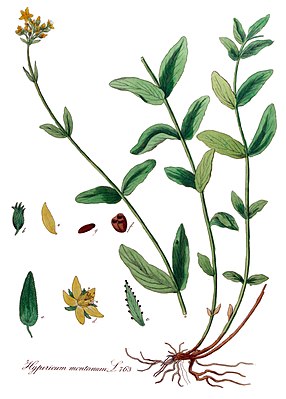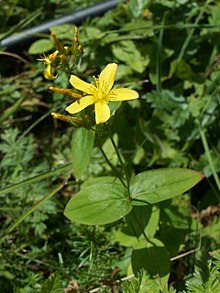St. John's wort
| St. John's wort | ||||||||||||
|---|---|---|---|---|---|---|---|---|---|---|---|---|

Mountain St. John's Wort ( Hypericum montanum ), illustration |
||||||||||||
| Systematics | ||||||||||||
|
||||||||||||
| Scientific name | ||||||||||||
| Hypericum montanum | ||||||||||||
| L. |
The mountain St. John's wort ( Hypericum montanum ), also called mountain hard hay , is a type of plant from the St. John's wort family . Despite its name, the mountain St. John's wort is not a pure mountain plant. It is widespread in Central Europe, but nowhere is it particularly common. It can be found in the Alps up to an altitude of 1500 meters.
description
The mountain St. John's wort is a perennial herbaceous plant that reaches heights of 30 to 80 centimeters and has an upright bare stem . It overwinters covered by leaves or earth, which is why it is called a hemicryptophyte . The egg-shaped to elliptical leaves sit opposite on the stem and encompass this somewhat at the base. At the edge, the 2 to 6 cm long leaves have a row of black glandular points. In addition, the undersides of the leaves are short haired along the nerves. The distances between the pairs of leaves are significantly larger in the upper part of the stem than the leaves themselves.
The inflorescence is dense (almost head-shaped) only at the upper end of the stems. Towards the bottom it is loosened up by partial inflorescences sitting on short side branches (arm-flowered). There they sprout from the upper leaf axils. The radially symmetrical flowers are hermaphroditic. The five to six millimeters long sepals are pointed lanceolate and have clearly stalked black glands on the edge. The five yellow petals are about 10 mm long. The flower has numerous stamens. The flowering period extends from June to August.
The number of chromosomes is 2n = 16.
ecology
This species occurs in smaller to larger groups. They are fertilized by self or insect pollination . The species spreads mainly by self-spread .
Distribution and location requirements
This species is distributed throughout Europe up to an altitude of 1500 m. Outside of Europe only a few smaller occurrences are known in Morocco , Turkey and Georgia . In the Allgäu Alps, in the Tyrolean part of the Heuberg near Häselgehr , it rises to an altitude of 1500 meters.
The mountain St. John's wort is found mainly on dry and semi- arid grasslands as well as in deciduous and fir forests and bushes in dry and warm locations. As ecological indicator values according to Ellenberg , the species is given as a penumbral plant for moderately warm to warm locations with a moderate maritime climate. The displayed soil condition is then evenly dry to moderately moist, never very acidic, but low in nitrogen. It is a weak character species of the order Quercetalia pubescenti-petraeae, but also occurs in societies of the associations Fagion, Carpinion, berberidion or Geranion sanguinei.
Sources and further information
The article is mainly based on the following documents:
- Oskar Sebald : Guide through nature. Wild plants of Central Europe. ADAC Verlag, Munich 1989, ISBN 3-87003-352-5 .
Individual evidence
- ↑ Oskar Sebald: Guide through the nature of wild plants in Central Europe. ADAC Verlag, Munich 1989, ISBN 3-87003-352-5 , p. 67.
- ↑ a b Erich Oberdorfer : Plant-sociological excursion flora for Germany and neighboring areas . With the collaboration of Angelika Schwabe and Theo Müller. 8th, heavily revised and expanded edition. Eugen Ulmer, Stuttgart (Hohenheim) 2001, ISBN 3-8001-3131-5 , pp. 665 .
- ↑ Erhard Dörr, Wolfgang Lippert : Flora of the Allgäu and its surroundings. Volume 2, IHW, Eching 2004, ISBN 3-930167-61-1 , p. 221.
Web links
- St. John's wort. In: FloraWeb.de.
- Profile and distribution map for Bavaria . In: Botanical Information Hub of Bavaria .
- Hypericum montanum L., map for distribution in Switzerland In: Info Flora , the national data and information center for Swiss flora .
- Profile at Ecological Database of the British Isles (English)
- Area map to Hultén
- Thomas Meyer: Data sheet with identification key and photos at Flora-de: Flora von Deutschland (old name of the website: Flowers in Swabia )
- Entry on GRIN (English)

